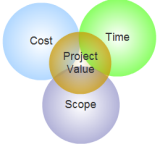Value Management in Projects – Definition and Goals

 In the broadest sense, value management defines a process of delivering some benefit to a client. When we talk about project implementation, delivery of expected results, and organization of activities, value management concerns the benefits the customer derives from successfully implementing a given project.
In the broadest sense, value management defines a process of delivering some benefit to a client. When we talk about project implementation, delivery of expected results, and organization of activities, value management concerns the benefits the customer derives from successfully implementing a given project.
Let’s see an example. Activities for creating a better working environment and improving the skills of customer support staff can be organized into a single project that should deliver the following:
- some value to the customer, and
- some profit to the organization.
The value of this project would be that customers receive better support service (the benefit) because the number of satisfied requests increases. The business profit would be that the organization gets more loyal customers and earns a better reputation because the customers are happy and ready to purchase more products or order new services.
That is all briefly about the concept of value management in projects. Now let’s review the definition and goals of this concept.
Value Management Definition
Value management is a combination of planning tools and methods to find the optimum balance of project benefits in relation to costs and risks. It is the process of planning, assessing, and developing the project to make the right decisions about the optimized balance of the benefits, risks, and costs. Project value management allows for increasing the likelihood of producing the deliverables and creating the benefits.
Following the given value management definition, a project manager needs to know how to critically appraise and analyze all tasks, activities, and processes involved in the project to determine whether better value alternatives or solutions are available and to apply the right decisions. The main idea here is to minimize the number of wasteful processes and avoid inefficiency in specific aspects of project implementation.
Project Value and Benefits Management
Value management is close to benefits management, but these two concepts in project management are different.
When discussing managing benefits within a project, we focus on the actual results associated with the expectations to define whether the benefits are delivered to the customer. Therefore, project benefits management is generally about planning the deliverables of the project.
Meanwhile, value planning and management within a project is about balancing the expected benefits with available financial resources and mitigating the probability of risk occurrence that may cause project failure. Therefore, when we talk about project value management, we focus on cost analysis and risk mitigation and look for ways to make the benefits valued to the customer.
One such way to do this is to lean on solid data.
Projections and predictions based on this data are essential for communicating the value of a project and planning and preparing for the risks, as mentioned above—this matters to your clients: the hard facts and quantifiable data representing your project’s expected value.
The key to this is to make it accessible and easy to understand. Raw data can be impregnable to the uninitiated. So you want to identify the essential statistics and facts and convert them into comprehensible actions and statements.
When the project brings some value, it is worth implementing and can be qualified in business terms. The customer gets the benefit, and the performing organization (which implements the project) receives some profit.
The importance of implementing project value management is enabling customers to set and achieve their needs through workshops and status meetings that facilitate teamwork, collaboration, and end-user buy-in. In addition, implementing various value management models allows for focusing on function and value for money rather than cutting costs.
The Goals of Managing Project Value
Managing project value is a continuous enhancement process. Although it’s about something other than reducing cost, this process’s tools and methods aim to achieve the required quality of the project product throughout the project implementation process.
The primary purpose consists of maximizing project value in relation to time, cost, and quality constraints. Risks play a pivotal role when managing cost, time, and quality, so the value management process should also address them.
Multiple methods and approaches for managing value pursue the same set of goals, including the following ones:
- To achieve a better understanding of the business needs of the performing organization
- To set a simple and straightforward definition of specific stakeholder needs
- To consider all options, alternatives, and innovative ideas regarding project implementation and product delivery
- To achieve optimum value for money while satisfying the range of customer requirements
- To minimize the likelihood of unnecessary expenditure by reducing waste and inefficiency
- To improve collaboration and communication with customers.
What is Business Value in Project Management?
Business value is a monetary measure of an organization’s benefit from investing in specific projects. You can think of business value in terms of the quality and quantity of income a given project generates over time.
For example, if a project increases revenue from $1 million to $1.5 million within one year, it has produced $500,000 of the value measured in dollars. Likewise, if a project reduces the time it takes a team to complete work by 50%, it saves the organization $150,000 in labor costs, including salary and benefits. This project enhances team efficiency and makes better use of technology.
Business value is different from return on investment (ROI). ROI is a measure of the money an organization earns from a fixed investment. The business value measures how much increased revenue, reduced time, etc. that the organization acquires over a fixed amount of investment.
Suppose an organization invests $100,000 in a construction project that results in $300,000 of value over the next year. Its ROI is theoretically 300%, but its business value is just 200% because the organization spent only $100,000 to generate an additional $200,000.
Wrapping Up
In summary, project value management is the process of balancing project benefits and available resources, including time, money, and people to ensure that the customer receives their expected value from a project.
By communicating that value to the customers, stakeholders, and other interested parties, you can make sure that everyone’s needs are met from the project. This is one of the most important aspects of successful project implementation.
So, the next time a project is in line for your team to take on, remember the importance of managing value—it will make all the difference. And when it comes to managing value within your organization, you don’t want to be caught unawares. Making sure that you’re making the most of your precious resources will keep your company competitive.














